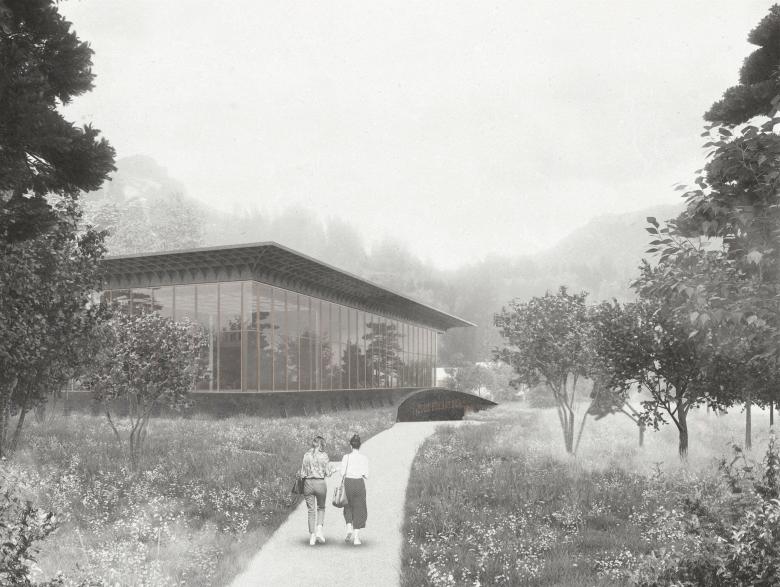Thermal Bath Oberstdorf
Back to Projects list- Location
- Oberstdorf, Germany
- Year
- 2019
- Client
- Markt Oberstdorf
- Team
- Michael Becker, Roland Schafroth
- Architecture cooperation
- Hermann Kaufmann + Partner ZT GmbH
- Landscape architecture
- Keller, Damm, Kollegen GmbH
- Technical planning
- IB Hirdina
- Fire protection planning
- Fire and Timber. Ing GmbH
- GFA
- 12.442 m2
- GA
- 51.999 m3
- Competition
The design of the thermal bath Oberstdorf and its outdoor spaces refers to the urban context of the surrounding area and subtly responds to its contexts and existing situations. Considered, beyond the boundaries of the property line, is the spa park and the potential spatial link to this public green space. A special quality lies in the close connection to the Haus Oberstdorf and the two churches located in the direct surroundings. Following these urban planning guidelines, the new spa is situated as a large-scale solitaire, as a pavilion in the park. Consequently, instead of closing itself off to the outside, an integrating concept is offered, which meaningfully relates the qualitative open spaces of the existing situation and at the same time offers the new Therme a suitable, very atmospheric location. In order to create an adequate pedestrian connection, the traffic-calmed area of Prinzenstraße will be extended to the site of the Therme, thus developing a bridge across Ludwigstraße. Another connection point is generated via the upgraded west side of Haus Oberstdorf to the spa park. Through these measures, a large-scale connection can be established, which creates a coherent, new, green and usable overall space for the public. The small-scale context of the single-family house development directly adjacent to the newly created park space and the resulting grain is taken into account by the targeted placement of the space-creating stones on the base floor.
The building follows the design image of the socketed, a wooden pavilion resting on stones in the park, which merges with the landscape and the surrounding mountain world while providing the greatest possible intimacy. The spatial concept of the spa is based on a hollowed-out, salvaged base, which subtly separates the bathing level from the surrounding public park space, and on which stone blocks extending over two floors are situated, which support both the wooden roof-space structure as well as the self-sufficiently decoupled sauna and wellness floor in wood. This entire spatial structure is enclosed by a metal facade that forms the thermal envelope. The necessary privacy filter of the suspended wooden floor is formed, where necessary, by a matted course of the interior facades. In this way, intertwined interior and exterior spaces are created, which make this joining of materials and constructions tangible with all the senses. Following the idea of the stone hollowed by the water, the spatial structure develops towards the light after diving into the park, in order to emerge on the base with the greatest possible reference to the park and the mountain, or in order to open up the overlying, penetrated wooden storey through the stones lying on the base, which also interlocks with all the structures both inside and outside and acts as a mediator to the crowning roofscape.
The interior spaces of the spa alternate between a cave-like system inside the base and stones, a vibrant interior space with blurring interior and exterior boundaries on the base and sublime views of the treetops and surrounding mountains, and an intimate, geometrically layered and joined system of boxes supported on the stones. Here, the stone interiors resemble a structure hollowed by water, which contrasts with the joined structure of the wooden vessels on the sauna floor. Following the material properties of the respective vessel, the moisture-affected uses are designed in stone and the temperature-intensive uses in wood. The complex interweaving of these construction, material and spatial structures, both vertically and horizontally, creates a unique sense of space that appeals to all the senses.
The open space functions as a landscape, which can be walked through, experienced and felt. At the same time, it offers visitors a place of retreat that allows for relaxation and harmony. The design's pathways flow around the spa building like a river, linking it to Prinzenstrasse, Ludwigstrasse and Promenadenstrasse. The flowing forms offer visitors natural and uncomplicated access to the entire area. The required bicycle parking spaces are located in the entrance area on Prinzenstrasse and Ludwigstrasse. The new bus stop, the desired PWK visitor parking spaces and the access to the underground parking garage are also located on Ludwigstrasse. In order to maximize the green, public open space that can be experienced by pedestrians, the above-ground parking spaces are accessed directly from Promenadenstraße as angled parking.
To create the desired unique atmosphere, the vegetation concept responds suptil to the intertwining of exterior and interior spaces. A continuously increasing vegetation filter towards the outside creates a protected atmosphere without blocking view axes to the mountain landscape. The first layer of the vegetation filter from the building consists of cherry, apple and rock pear. Only recognizable at second glance, these tree plantings are oriented to the 6x6m grid of the building and yet remain in the landscape duct. The second layer of the planned planting is composed of the alpine species spectrum, such as mountain maple, larch, lime, pine, rowan or alder, and thus anchors the park in the natural environment and at the same time offers the opportunity to set striking accents with blossoms and autumn colors. The locations of these woody plants are now detached from the grid of the building, thus creating a reference to the surrounding vegetation structure. All woody plants thereby form a continuously increasing filter between the bath and the public open space and further to the private neighborhood. Two-shade meadow areas and wild shrubs underneath the woody plants complement the near-natural concept and thus also provide diverse, faunistic habitat.








